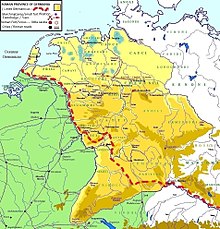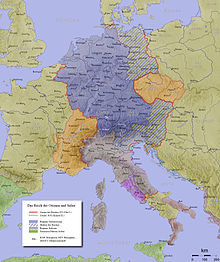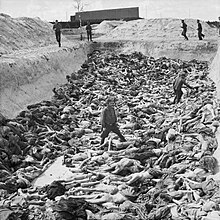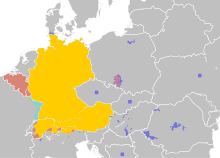Germans

Germans(German:Deutsche,pronounced[ˈdɔʏtʃə]) are the natives or inhabitants ofGermany,or sometimes more broadly any people who are of German descent or native speakers of theGerman language.[1][2]Theconstitution of Germany,implemented in 1949 following the end ofWorld War II,defines a German as aGerman citizen.[3]During the 19th and much of the 20th century, discussions on German identity were dominated by concepts of a common language, culture, descent, and history.[4]Today, the German language is widely seen as the primary, though not exclusive, criterion of German identity.[5]Estimates on the total number of Germans in the world range from 100 to 150 million, most of whom live in Germany.[6]
The history of Germans as anethnic groupbegan with the separation of a distinctKingdom of Germanyfrom theeastern partof theFrankish Empireunder theOttonian dynastyin the 10th century, forming the core of theHoly Roman Empire.In subsequent centuries the political power and population of this empire grew considerably. It expanded eastwards, and eventually a substantial number of Germans migrated further eastwards intoEastern Europe.The empire itself was politically divided between many small princedoms, cities and bishoprics. Following theReformationin the 16th century, many of these states found themselves in bitter conflict concerning the rise ofProtestantism.
In the 19th century, the Holy Roman Empire dissolved, andGerman nationalismbegan to grow. TheKingdom of Prussiaincorporatedmost Germans into itsGerman Empirein 1871, and a substantial additional number of Germans were in the multiethnic kingdom ofAustria-Hungary.During this time, a large number of Germans emigrated to theNew World,particularly to theUnited States,especially to present-dayPennsylvania.Large numbers also emigrated toCanadaandBrazil,and they established sizable communities inNew ZealandandAustralia.TheRussian Empirealso included a substantial German population.
Following the end ofWorld War I,Austria-Hungary and the German Empire were partitioned, resulting in many Germans becomingethnic minoritiesin newly established countries. In the chaotic years that followed,Adolf Hitlerbecame the dictator ofNazi Germanyand embarked on a genocidal campaign to unify all Germans under his leadership. His Nazi movement defined Germans in a very broad way which includedAustrians,Luxembourgers,easternBelgians,and so-calledVolksdeutsche,which were ethnic Germans elsewhere in Europe and globally. However, this Nazi conception expressly excluded German citizens ofJewishorRomabackground. Nazi policies of military aggression and its persecution of those deemed non-Germans in theHolocaustled toWorld War IIin which the Nazi regime was defeated byallied powers,led by theUnited States,theUnited Kingdom,and the formerSoviet Union.In the aftermath of Germany's defeat in the war, the country was occupied and once again partitioned. Millions of Germans wereexpelledfrom Central and Eastern Europe. In 1990,West GermanyandEast Germanywerereunified.In modern times, remembrance of the Holocaust, known asErinnerungskultur( "culture of remembrance" ), has become an integral part of German identity.
Owing to their long history of political fragmentation, Germans are culturally diverse and often have strong regional identities. Arts and sciences are an integral part ofGerman culture,and the Germans have been represented by many prominent personalities in a significant number of disciplines, includingNobel prize laureateswhere Germany is rankedthirdamong countries of the world in the number of total recipients.
Names
The English termGermansis derived from theethnonymGermani,which was used for Germanic peoples in ancient times.[7][8]Since the early modern period, it has been the most common name for the Germans in English. The termGermansmay also be applied to any citizens, natives or inhabitants of Germany, regardless of whether they are considered to have German ethnicity.
In some contexts, people of German descent are also called Germans.[2][1]In historical discussions the term "Germans" is also occasionally used as a way to refer to members of the Germanic peoples during the time of the Roman empire.[1][9][10]
The GermanendonymDeutscheis derived from theHigh Germantermdiutisc,which means "ethnic" or "relating to the people". This term was used for speakers of West-Germanic languages in Central Europe since at least the 8th century, after which time a distinct German ethnic identity began to emerge among at least some them living within the Holy Roman Empire.[7]However, variants of the same term were also used in theLow Countries,for the related dialects of what is still calledDutchin English.
History

Ancient history

The first information about the peoples living in what is now Germany was provided by the Roman general and politicianJulius Caesar,who gave an account of his conquest ofGaulin the 1st century BC. Gaul included parts of what is now Germany, west of theRhineriver. He specifically noted the potential future threat which could come from the related people east of the river. Under Caesar's successors, the Romans began to conquer and control the entire region between the Rhine and the Elbe which centuries later constituted the core of medieval Germany. These efforts were significantly hampered by the victory of a local alliance led byArminiusat theBattle of the Teutoburg Forestin 9 AD, which is considered a defining moment in German history.[11]The early Germanic peoples were later famously described in more detail inGermaniaby the 1st century Roman historianTacitus.At this time, the Germanic peoples, orGermani,were fragmented into a large number of peoples who were frequently in conflict with both the Roman Empire and one another.[12]He described them as a diverse group, dominating a much larger area than Germany, stretching to theVistulain the east, andScandinaviain the north.
At the time of Caesar's invasion, much of Central Europe was inhabited byCeltsand strongly influenced by the celticLa Tènematerial culture.[11]Since at least the 2nd century BC, theGermanic languagesassociated with later Germanic peoples began approaching the Rhine areas.[13]The resulting demographic situation closer to the Romans was likely an assimilation of Celts and migrating Germanic peoples.[11]Scholars generally agree that it is possible to speak of Germanic languages existing as early as 500 BCE.[14]These Germanic languages are believed to have dispersed towards the Rhine from the direction of theJastorf culture,which was a Celtic influenced culture that existed in thePre-Roman Iron Age,in the region near the Elbe river. It is likely thatfirst Germanic consonant shift,which defines the Germanic language family, occurred during this period.[15]The earlierNordic Bronze Ageof southern Scandinavia also shows definite population and material continuities with the Jastorf Culture,[16]but it is unclear whether these indicate ethnic continuity.[17]
Medieval history


German ethnicity emerged in medieval times among the descendants of the RomanizedGermanic peoplesin the area of modern western Germany, between the Rhine and Elbe rivers, includingFranks,Frisians,Saxons,Thuringii,AlemanniandBaiuvarii.[11] These peoples had been under the dominance of the western Franks starting withClovis I,who established control of the Romanized and Frankish population of Gaul in the 5th century, and began a process of conquering the peoples east of the Rhine. The regions long continued to be divided into "Stem duchies",corresponding to the old ethnic designations.[13]
By the early 9th century AD, large parts of Europe were united under the rule of the Frankish leaderCharlemagne,who expanded theFrankish empirein several directions including east of the Rhine, where he consolidated power over theSaxonsandFrisians,thus establishing theCarolingian Empire.Charlemagne was crowned emperor byPope Leo Iin 800.[13]In the generations after Charlemagne the empire was partitioned at theTreaty of Verdun(843), eventually resulting in the long-term separation between the states ofWest Francia,Middle FranciaandEast Francia.Beginning withHenry the Fowler,non-Frankish dynasties also ruled the eastern kingdom, and under his sonOtto I,East Francia, which was mostly German, constituted the core of theHoly Roman Empire.[18]Also under control of this loosely controlled empire were the previously independent kingdoms ofItaly,Burgundy,andLotharingia.The latter was a Roman and Frankish area which contained some of the oldest and most important German cities including Aachen, Cologne and Trier, all west of the Rhine. Leaders of the stem duchies which constituted this eastern kingdom —Bavaria,Franconia,Swabia,andSaxony― continued to wield considerable power independently of the king.[13]German kings were elected by members of the noble families, who often sought to have weak kings elected in order to preserve their own independence. This prevented an early unification of the Germans.[19][20]
A warrior nobility dominated thefeudalGerman society of the Middle Ages, while most of the German population consisted of peasants with few political rights.[13]The church played an important role among Germans in the Middle Ages, and competed with the nobility for power.[21]Between the 11th and 13th centuries, Germans actively participated in fiveCrusadesto "liberate" theHoly Land.[21]From the beginnings of the kingdom, its dynasties also participated in a push eastwards into Slavic-speaking regions. At theSaxon Eastern Marchin the north, thePolabian Slavseast of the Elbe were conquered over generations of often brutal conflict. Under the later control of powerful German dynasties it became an important region within modern Germany, and home to its modern capital, Berlin. German population also moved eastwards from the 11th century, in what is known as theOstsiedlung.[20]Over time, Slavic and German-speaking populations assimilated, meaning that many modern Germans have substantial Slavic ancestry.[18]From the 12th century, many Germans settled as merchants and craftsmen in theKingdom of Poland,where they came to constitute a significant proportion of the population in many urban centers such asGdańsk.[18]During the 13th century, theTeutonic Knightsbegan conquering theOld Prussians,and established what would eventually become the powerful German state ofPrussia.[20]
Further south,BohemiaandHungarydeveloped as kingdoms with their own non-German speaking elites. TheAustrian Marchon theMiddle Danubestopped expanding eastwards towards Hungary in the 11th century. UnderOttokar II,Bohemia (corresponding roughly to modern Czechia) became a kingdom within the empire, and even managed to take control of Austria, which was German-speaking. However, the late 13th century saw the election ofRudolf Iof theHouse of Habsburgto the imperial throne, and he was able to acquire Austria for his own family. The Habsburgs would continue to play an important role in European history for centuries afterwards. The Holy Roman Empire itself remained weak, and by the late Middle Ages much of Lotharingia and Burgundy had come under the control of French dynasts, theHouse of Valois-BurgundyandHouse of Valois-Anjou.Italy, Switzerland and Savoy were no longer subject to effective imperial control.
Trade increased and there was a specialization of the arts and crafts.[21]In the late Middle Ages the German economy grew under the influence of urban centers, which increased in size and wealth and formed powerful leagues, such as theHanseatic Leagueand theSwabian League,in order to protect their interests, often through supporting the German kings in their struggles with the nobility.[20]These urban leagues significantly contributed to the development of German commerce and banking. German merchants of Hanseatic cities settled in cities throughout Northern Europe beyond the German lands.[22]
Modern history



The Habsburg dynasty managed to maintain their grip upon the imperial throne in theearly modern period.While the empire itself continued to be largely de-centralized, the Habsburgs own personal power increased outside of the core German lands.Charles Vpersonally inherited control of the kingdoms of Hungary and Bohemia, the wealthy low countries (roughly modern Belgium, Luxembourg and the Netherlands), the Kingdoms of Castile, Aragon, Sicily, Naples, and Sardinia, and the Dukedom of Milan. Of these, the Bohemian and Hungarian titles remained connected to the imperial throne for centuries, making Austria a powerful multilingual empire in its own right. On the other hand, the low countries went to the Spanish crown and continued to evolve separately from Germany.
The introduction of printing by the German inventorJohannes Gutenbergcontributed to the formation of a new understanding of faith and reason. At this time, the German monkMartin Lutherpushed for reforms within the Catholic Church. Luther's efforts culminated in theProtestant Reformation.[21]
Religious schism was a leading cause of theThirty Years' War,a conflict that tore apart the Holy Roman Empire and its neighbours, leading to the death of millions of Germans. The terms of thePeace of Westphalia(1648) ending the war, included a major reduction in the central authority of the Holy Roman Emperor.[23]Among the most powerful German states to emerge in the aftermath was ProtestantPrussia,under the rule of theHouse of Hohenzollern.[24]Charles V and his Habsburg dynasty defended Roman Catholicism.
In the 18th century, German culture was significantly influenced by theEnlightenment.[23]
After centuries of political fragmentation, a sense of German unity began to emerge in the 18th century.[7]The Holy Roman Empire continued to decline until beingdissolvedaltogether byNapoleonin 1806. In central Europe, the Napoleonic wars ushered in great social, political and economic changes, and catalyzed anational awakeningamong the Germans. By the late 18th century, German intellectuals such asJohann Gottfried Herderarticulated the concept of a German identity rooted in language, and this notion helped spark theGerman nationalistmovement, which sought to unify the Germans into a singlenation state.[19]Eventually, shared ancestry, culture and language (though not religion) came to define German nationalism.[12]TheNapoleonic Warsended with theCongress of Vienna(1815), and left most of the German states loosely united under theGerman Confederation.The confederation came to be dominated by the CatholicAustrian Empire,to the dismay of many German nationalists, who saw the German Confederation as an inadequate answer to theGerman Question.[24]
Throughout the 19th century, Prussia continued to grow in power.[25]In 1848,German revolutionaries set up the temporaryFrankfurt Parliament,but failed in their aim of forming a united German homeland. The Prussians proposed anErfurt Unionof the German states, but this effort was torpedoed by the Austrians through thePunctation of Olmütz(1850), recreating the German Confederation. In response, Prussia sought to use theZollvereincustoms union to increase its power among the German states.[24]Under the leadership ofOtto von Bismarck,Prussia expanded its sphere of influence and together with its German allies defeatedDenmarkin theSecond Schleswig Warand soon afterAustriain theAustro-Prussian War,subsequently establishing theNorth German Confederation.In 1871, the Prussian coalition decisively defeated theSecond French Empirein theFranco-Prussian War,annexing the German speaking region ofAlsace-Lorraine.After taking Paris, Prussia and their alliesproclaimedthe formation of a unitedGerman Empire.[19]
In the years following unification, German society was radically changed by numerous processes, including industrialization, rationalization, secularization and the rise of capitalism.[25]German power increased considerably and numerous overseas colonies were established.[26]During this time, the German population grew considerably, and many emigrated to other countries (mainly North America), contributing to the growth of theGerman diaspora.Competition for colonies between the Great Powers contributed to the outbreak ofWorld War I,in which the German, Austro-Hungarian andOttoman Empiresformed theCentral Powers,an alliance that was ultimately defeated, with none of the empires comprising it surviving the aftermath of the war. Under the terms of the Treaty of Versailles, the German and Austro-Hungarian Empires were both dissolved and partitioned, resulting in millions of Germans becoming ethnic minorities in other countries.[27]The monarchical rulers of the German states, including the German emperorWilhelm II,were overthrown in theNovember Revolutionwhich led to the establishment of theWeimar Republic.The Germans of theAustrianside of theDual Monarchyproclaimed theRepublic of German-Austria,and sought to be incorporated into the German state, but this was forbidden by theTreaty of VersaillesandTreaty of Saint-Germain.[26]
What many Germans saw as the "humiliation of Versailles",[28]continuing traditions of authoritarian andantisemiticideologies,[25]and theGreat Depressionall contributed to the rise of Austrian-bornAdolf Hitlerand the Nazis, who after coming to power democratically in the early 1930s, abolished the Weimar Republic and formed the totalitarianThird Reich.In his quest to subjugate Europe, six millionJewswere murdered in theHolocaust.WWII resulted in widespread destruction and the deaths of tens of millions of soldiers and civilians, while the German state was partitioned. About 12 million Germanshad to flee or were expelledfrom Eastern Europe.[29]Significant damage was also done to the German reputation and identity,[27]which became far less nationalistic than it previously was.[28]
The German states ofWest GermanyandEast Germanybecame focal points of theCold War,but werereunifiedin 1990. Although there were fears that the reunified Germany might resume nationalist politics, the country is today widely regarded as a "stablizing actor in the heart of Europe" and a "promoter of democratic integration".[28]
Language

Germanis the native language of most Germans. It is the key marker of German ethnic identity.[7][12]German is aWest Germaniclanguage closely related toFrisian(in particularNorth FrisianandSaterland Frisian),Luxembourgish,English,Dutch,andLow German.[7]ModernStandard Germanis based onHigh GermanandCentral German,and is the first or second language of most Germans, but notably not theVolga Germans.[30]
Low German,which is often considered to be a distinct language from both German and Dutch, was the historical language of most of northern Germany, and is still spoken by many Germans, often as a second language.[citation needed]
Geographic distribution
It is estimated that there are over 100 million Germans today, most of whom live in Germany, where they constitute the majority of the population.[31]There are also sizable populations of Germans in Austria, Switzerland, the United States, Brazil, France, Kazakhstan, Russia, Argentina, Canada, Poland, Italy, Hungary, Australia, South Africa, Chile, Paraguay, and Namibia.[32][33]
Culture

The Germans are marked by great regional diversity, which makes identifying a single German culture quite difficult.[34]The arts and sciences have for centuries been an important part of German identity.[35]TheAge of Enlightenmentand theRomantic erasaw a notable flourishing of German culture. Germans of this period who contributed significantly to the arts and sciences include the writersJohann Wolfgang von Goethe,Friedrich Schiller,Johann Gottfried Herder,Friedrich Hölderlin,E. T. A. Hoffmann,Heinrich Heine,Novalisand theBrothers Grimm,the philosopherImmanuel Kant,the architectKarl Friedrich Schinkel,the painterCaspar David Friedrich,and the composersJohann Sebastian Bach,Ludwig van Beethoven,Wolfgang Amadeus Mozart,Joseph Haydn,Johannes Brahms,Franz Schubert,Richard StraussandRichard Wagner.[34]
Popular German dishes includebrown breadandstew.Germans consume a high amount ofalcohol,particularly beer, compared to other European peoples. Obesity is relatively widespread among Germans.[34]
Carnival(German:Karneval,Fasching,orFastnacht) is an important part of German culture, particularly inSouthern Germanyand theRhineland.An important German festival is theOktoberfest.[34]
A steadily shrinking majority of Germans areChristians.About a third areRoman Catholics,while one third adheres toProtestantism.Another third does not profess any religion.[12]Christian holidays such asChristmasandEasterare celebrated by many Germans.[36]The number ofMuslimsis growing.[36]There is also a notableJewishcommunity, which was decimated in the Holocaust.[37]Rememberingthe Holocaustis an important part of German culture.[25]
Identity
A German ethnic identity began to emerge during theearly medieval period.[38]These peoples came to be referred to by the High German termdiutisc,which means "ethnic" or "relating to the people". The German endonymDeutscheis derived from this word.[7]In subsequent centuries, the German lands were relatively decentralized, leading to the maintenance of a number of strong regional identities.[19][20]
The German nationalist movement emerged among German intellectuals in the late 18th century. They saw the Germans as a people united by language and advocated the unification of all Germans into a single nation state, which was partially achieved in 1871. By the late 19th and early 20th century, German identity came to be defined by a shared descent, culture, and history.[4]Völkischelements identified Germanness with "a shared Christian heritage" and "biological essence", to the exclusion of the notable Jewish minority.[39]After the Holocaust and the downfall of Nazism, "any confident sense of Germanness had become suspect, if not impossible".[40]East Germany and West Germany both sought to build up an identity on historical or ideological lines, distancing themselves both from the Nazi past and each other.[40]After German reunification in 1990, the political discourse was characterized by the idea of a "shared, ethnoculturally defined Germanness", and the general climate became increasingly xenophobic during the 1990s.[40]Today, discussion on Germanness may stress various aspects, such as commitment to pluralism and the German constitution (constitutional patriotism),[41]or the notion of aKulturnation(nation sharing a common culture).[42]The German language remains the primary criterion of modern German identity.[4]
See also
- Ethnic groups in Europe
- German diaspora
- Die Deutschen,ZDF's documentary television series
- Anti-German sentiment
- Germanophile
- Persecution of Germans
- Demographics of Germany
Notes
References
- ^abc"German Definition & Meaning".Merriam-Webster.Archivedfrom the original on 13 November 2020.Retrieved25 November2020.
- ^ab"German".Oxford Dictionary of English.Oxford University Press.2010. p. 733.ISBN978-0199571123.Archivedfrom the original on 4 February 2021.Retrieved22 December2020.
- ^Bundesministerium der Justiz und für Verbraucherschutz(ed.). "Article 116".Basic Law for the Federal Republic of Germany.Archivedfrom the original on 7 November 2020.Retrieved3 June2021.
Unless otherwise provided by a law, a German within the meaning of this Basic Law is a person who possesses German citizenship or who has been admitted to the territory of the German Reich within the boundaries of 31 December 1937 as a refugee or expellee of German ethnic origin or as the spouse or descendant of such person.
- ^abcMoser 2011,p. 172. "German identity developed through a long historical process that led, in the late 19th and early 20th centuries, to the definition of the German nation as both a community of descent (Volksgemeinschaft) and shared culture and experience. Today, the German language is the primary though not exclusive criterion of German identity. "
- ^Haarmann 2015,p. 313. "After centuries of political fragmentation, a sense of national unity as Germans began to evolve in the eighteenth century, and the German language became a key marker of national identity."
- ^Moser 2011,p. 171. "The Germans live in Central Europe, mostly in Germany... Estimates of the total number of Germans in the world range from 100 million to 150 million, depending on how German is defined, but it is probably more appropriate to accept the lower figure."
- ^abcdefHaarmann 2015,p. 313.
- ^Hoad, T. F. (2003)."German".The Concise Oxford Dictionary of English Etymology.Oxford University Press.doi:10.1093/acref/9780192830982.001.0001.ISBN9780192830982.Archivedfrom the original on 24 September 2021.Retrieved22 December2020.
- ^"Germans".Columbia Electronic Encyclopedia.Columbia University Press.2013.Archivedfrom the original on 30 November 2020.Retrieved5 December2020.
- ^Drinkwater, John Frederick(2012)."Germans".InHornblower, Simon;Spawforth, Antony;Eidinow, Esther(eds.).The Oxford Classical Dictionary(4 ed.).Oxford University Press.p. 613.doi:10.1093/acref/9780199545568.001.0001.ISBN9780191735257.Archivedfrom the original on 9 June 2021.Retrieved22 December2020.
- ^abcdHeather, Peter."Germany: Ancient History".Encyclopædia Britannica Online.Encyclopædia Britannica, Inc.Archivedfrom the original on 31 March 2019.Retrieved21 November2020.
Within the boundaries of present-day Germany... Germanic peoples such as the eastern Franks, Frisians, Saxons, Thuringians, Alemanni, and Bavarians—all speaking West Germanic dialects—had merged Germanic and borrowed Roman cultural features. It was among these groups that a German language and ethnic identity would gradually develop during the Middle Ages.
- ^abcdMoser 2011,p. 172.
- ^abcdeMinahan 2000,pp. 288–289.
- ^Steuer 2021,p. 32.
- ^Steuer 2021,p. 89, 1310.
- ^Timpe & Scardigli 2010,p. 636.
- ^Todd 1999,p. 11.
- ^abcHaarmann 2015,pp. 313–314.
- ^abcdHaarmann 2015,p. 314.
- ^abcdeMinahan 2000,pp. 289–290.
- ^abcdMoser 2011,p. 173.
- ^Minahan 2000,p. 290.
- ^abMoser 2011,pp. 173–174.
- ^abcMinahan 2000,pp. 290–291.
- ^abcdeMoser 2011,p. 174.
- ^abMinahan 2000,pp. 291–292.
- ^abHaarmann 2015,pp. 314–315.
- ^abcHaarmann 2015,p. 316.
- ^Troebst, Stefan (2012). "The Discourse on Forced Migration and European Culture of Remembrance".The Hungarian Historical Review.1(3/4): 397–414.JSTOR42568610.
- ^Minahan 2000,p. 288.
- ^Moser 2011,pp. 171–172.
- ^Haarmann 2015,p. 313. "Of the 100 million German speakers worldwide, about three quarters (76 million) live in Germany, where they account for 92 percent of the population. Populations of Germans live elsewhere in Central and Western Europe, with the largest communities in Austria (7.6 million), Switzerland (4.2 million), France (1.2 million), Kazakhstan (900,000), Russia (840,000), Poland (700,000), Italy (280,000), and Hungary (250,000). Some 1.6 million U.S. citizens speak German as their first language, the largest number of German speakers overseas."
- ^Moser 2011,pp. 171–172. "The Germans live in Central Europe, mostly in Germany... The largest populations outside of these countries are found in the United States (5 million), Brazil (3 million), the former Soviet Union (2 million), Argentina (500,000), Canada (450,000), Spain (170,000), Australia (110,000), the United Kingdom (100,000), and South Africa (75,000)."
- ^abcdMoser 2011,pp. 176–177.
- ^Waldman & Mason 2005,pp. 334–335.
- ^abMoser 2011,p. 176.
- ^Minahan 2000,p. 174.
- ^Haarmann 2015,p. 313 "Germans are a Germanic (or Teutonic) people that are indigenous to Central Europe... Germanic tribes have inhabited Central Europe since at least Roman times, but it was not until the early Middle Ages that a distinct German ethnic identity began to emerge."
- ^Rock 2019,p. 32.
- ^abcRock 2019,p. 33.
- ^Rock 2019,pp. 33–34.
- ^Rock 2019,p. 34.
Bibliography
- Haarmann, Harald(2015)."Germans".InDanver, Steven(ed.).Native Peoples of the World: An Encyclopedia of Groups, Cultures and Contemporary Issues.Routledge.pp. 313–316.ISBN978-1317464006.Archivedfrom the original on 14 October 2017.Retrieved22 June2018.
- Moser, Johannes(2011)."Germans".InCole, Jeffrey(ed.).Ethnic Groups of Europe: An Encyclopedia.ABC-CLIO.pp. 171–177.ISBN978-1598843026.Archivedfrom the original on 10 January 2017.Retrieved25 October2015.
- Minahan, James (2000)."Germans".One Europe, Many Nations: A Historical Dictionary of European National Groups.Greenwood Publishing Group.pp. 287–294.ISBN0313309841.Archivedfrom the original on 21 March 2015.Retrieved11 March2016.
- Steuer, Heiko (2021).Germanen aus Sicht der Archäologie: Neue Thesen zu einem alten Thema.de Gruyter.
- Timpe, Dieter; Scardigli, Barbara; et al. (2010) [1998]."Germanen, Germania, Germanische Altertumskunde".Germanische Altertumskunde Online.pp. 363–876.Archivedfrom the original on 17 August 2021.Retrieved22 April2023.
- Todd, Malcolm(1999).The Early Germans(2009 ed.). John Wiley & Sons.ISBN978-1-4051-3756-0.Archivedfrom the original on 23 April 2023.Retrieved22 April2023.
- Waldman, Carl; Mason, Catherine (2005)."Germans".Encyclopedia of European Peoples.Infobase Publishing.pp. 330–335.ISBN1438129181.Archivedfrom the original on 28 November 2015.Retrieved22 December2020.
Further reading
- Craig, Gordon Alexander(1983).The Germans.New American Library.ISBN0452006228.Archivedfrom the original on 27 May 2021.Retrieved23 December2020.
- Elias, Norbert(1996).The Germans.Columbia University Press.ISBN0231105630.Archivedfrom the original on 27 May 2021.Retrieved23 December2020.
- James, Harold(2000).A German Identity(2 ed.).Phoenix Press.ISBN1842122045.Archivedfrom the original on 27 May 2021.Retrieved23 December2020.
- Mallory, J. P.(1991). "Germans".In Search of the Indo-Europeans: Language Archeology and Myth.Thames & Hudson.pp. 84–87.Archivedfrom the original on 3 March 2021.Retrieved23 December2020.
- Rock, Lena(2019).As German as Kafka: Identity and Singularity in German Literature around 1900 and 2000.Leuven University Press.doi:10.2307/j.ctvss3xg0.ISBN9789462701786.JSTORj.ctvss3xg0.S2CID241563332.
- Todd, Malcolm(2004a).The Early Germans.Blackwell Publishing.ISBN9781405117142.Archivedfrom the original on 5 August 2020.Retrieved23 December2020.
- Wells, Peter S.(2011)."The Ancient Germans".InBonfante, Larissa(ed.).The Barbarians of Ancient Europe.Cambridge University Press.pp. 211–232.ISBN978-0-521-19404-4.Archivedfrom the original on 27 May 2021.Retrieved23 December2020.
